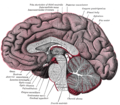Pia mater
Pia mater is the delicate innermost layer of the meninges, the membranes surrounding the brain and spinal cord. Pia mater is sometimes referred to as "pious mother" because it gently covers the brain. It is a very thin and delicate membrane composed of fibrous tissue and covered on its outer surface by a sheet of flat cells thought to be impermeable to fluid.
Structure[edit]
The pia mater is a very delicate impermeable membrane. It follows all the minor contours of the brain surface, dipping into sulci and fissures. It carries small blood vessels to nourish the brain. The pia mater is pierced by blood vessels to the brain and spinal cord, and its capillaries are responsible for nourishing the brain.
Function[edit]
The pia mater works with the other meningeal layers to protect and nourish the brain. It provides a barrier between the brain and the cerebrospinal fluid, which bathes the brain and spinal cord. The pia mater also helps to contain and circulate cerebrospinal fluid.
Clinical significance[edit]
Damage or disease of the pia mater can have serious neurological consequences. Infections of the pia mater can lead to meningitis, a potentially life-threatening condition. Other conditions, such as arachnoiditis, can also affect the pia mater.
See also[edit]
References[edit]
<references />
|
|
|
Pia mater[edit]
-
Gray770-en.svg
-
Gray767.png
-
Brain with arachnoid and pia mater
-
Meninges-en.svg
-
Brain Dissection - Pia Mater and Derivatives - Sanjoy Sanyal
-
Gray720.png
-
Gray749.png
-
Gray769-en.svg
-
Gray1196.png
-
Viorel Pais - Ultrastructural diagram of the cerebral cortex
Ad. Transform your life with W8MD's Budget GLP-1 injections from $75


W8MD offers a medical weight loss program to lose weight in Philadelphia. Our physician-supervised medical weight loss provides:
- Weight loss injections in NYC (generic and brand names):
- Zepbound / Mounjaro, Wegovy / Ozempic, Saxenda
- Most insurances accepted or discounted self-pay rates. We will obtain insurance prior authorizations if needed.
- Generic GLP1 weight loss injections from $75 for the starting dose.
- Also offer prescription weight loss medications including Phentermine, Qsymia, Diethylpropion, Contrave etc.
NYC weight loss doctor appointmentsNYC weight loss doctor appointments
Start your NYC weight loss journey today at our NYC medical weight loss and Philadelphia medical weight loss clinics.
- Call 718-946-5500 to lose weight in NYC or for medical weight loss in Philadelphia 215-676-2334.
- Tags:NYC medical weight loss, Philadelphia lose weight Zepbound NYC, Budget GLP1 weight loss injections, Wegovy Philadelphia, Wegovy NYC, Philadelphia medical weight loss, Brookly weight loss and Wegovy NYC
|
WikiMD's Wellness Encyclopedia |
| Let Food Be Thy Medicine Medicine Thy Food - Hippocrates |
Medical Disclaimer: WikiMD is not a substitute for professional medical advice. The information on WikiMD is provided as an information resource only, may be incorrect, outdated or misleading, and is not to be used or relied on for any diagnostic or treatment purposes. Please consult your health care provider before making any healthcare decisions or for guidance about a specific medical condition. WikiMD expressly disclaims responsibility, and shall have no liability, for any damages, loss, injury, or liability whatsoever suffered as a result of your reliance on the information contained in this site. By visiting this site you agree to the foregoing terms and conditions, which may from time to time be changed or supplemented by WikiMD. If you do not agree to the foregoing terms and conditions, you should not enter or use this site. See full disclaimer.
Credits:Most images are courtesy of Wikimedia commons, and templates, categories Wikipedia, licensed under CC BY SA or similar.
Translate this page: - East Asian
中文,
日本,
한국어,
South Asian
हिन्दी,
தமிழ்,
తెలుగు,
Urdu,
ಕನ್ನಡ,
Southeast Asian
Indonesian,
Vietnamese,
Thai,
မြန်မာဘာသာ,
বাংলা
European
español,
Deutsch,
français,
Greek,
português do Brasil,
polski,
română,
русский,
Nederlands,
norsk,
svenska,
suomi,
Italian
Middle Eastern & African
عربى,
Turkish,
Persian,
Hebrew,
Afrikaans,
isiZulu,
Kiswahili,
Other
Bulgarian,
Hungarian,
Czech,
Swedish,
മലയാളം,
मराठी,
ਪੰਜਾਬੀ,
ગુજરાતી,
Portuguese,
Ukrainian











